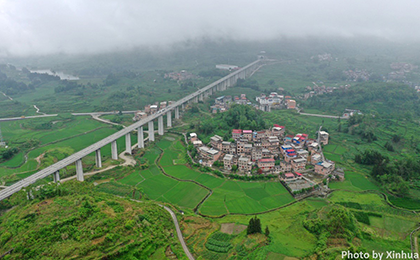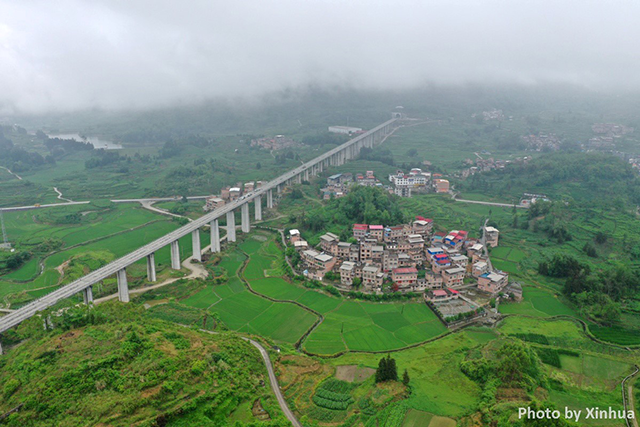



▲ A drone photograph shows the rural landscape of Xianan Township in Huanjiang Maonan Autonomous County, Guangxi. [Xinhua]
China aims to achieve substantial progress in all-around rural revitalization and promote the modernization of agriculture and rural areas to a new stage, according to the All-around Rural Revitalization Plan (2024-2027) issued by the Central Committee of the Communist Party of China and the State Council.
1. General Requirements.
1.1 Requirements.
Efforts should be made to promote high-quality development, anchored in the goal of building a strong agricultural country. A long-term mechanism should be established to drive all-around rural revitalization, with the fundamental goals of ensuring national food security and preventing large-scale rural population re-poverty. The achievements of poverty alleviation should be consolidated and expanded, focusing on enhancing rural industrial development, rural construction, and rural governance. Technological innovation and reform should serve as dual driving forces, with strong measures to increase farmers’ income. Accelerating agricultural and rural modernization will facilitate the all-around upgrading of agriculture, the comprehensive progress of rural areas, and the full development of farmers, thereby providing strong support for the overall goal of building a modern socialist country.
1.2 Goals.
By 2027, significant progress will be made in all-around rural revitalization, and agricultural and rural modernization will reach a new level. The foundation of national food security will be further strengthened, and the overall agricultural production capacity will steadily increase, ensuring that the Chinese population's food supply remains firmly in their own hands. Rural industries will be more prosperous, achieving full-chain industrial upgrades. Rural areas will become more ecologically livable, with notable improvements in living environments, and more complete infrastructure. The equalization of basic public services in urban and rural areas will be steadily increasing. Rural culture and ethics will continue to improve, with full inheritance and development of outstanding Chinese traditional culture, and a comprehensive enhancement of farmers’ overall quality. Rural governance will become more effective, with significant advancements in the modernization of governance systems and capabilities. Farmers’ living standards will improve, income levels will steadily rise, and a tiered and categorized assistance system for low-income rural populations and underdeveloped areas will be established. The developed regions in the east and suburban villages in cities of central and western regions where conditions permit will take the lead in achieving agricultural and rural modernization.
By 2035, decisive progress will be made in the comprehensive revitalization of rural areas, with agricultural modernization essentially realized and rural areas equipped with the basic conditions for modern living, the plan notes.
2. Optimizing Urban-Rural Development Patterns and Promoting Rural Revitalization in an Orderly Manner.
2.1 Coordinating and optimizing the layout of urban-rural development.
Based on the carrying capacity of resources and the evaluation of the environmental suitability of land development, the spatial layout of agriculture, ecology, and urbanization should be optimized. Strictly adhere to key control lines of arable land and permanent basic farmland, ecological protection red lines, and urban development boundaries. Scientifically prepare and implement county-level territorial planning.
Strengthen farmland protection, resolutely rectify illegal land occupation and destruction, and restore farmland in an orderly manner. Reform and improve the farmland equal policy of occupation and offset and the farmland quality verification mechanism to ensure both quantity and quality of farmland. Establish a management system to guarantee that farmland is used for planting key crops. Optimize rural functions and spatial layout to fully leverage the unique roles of rural areas in securing agricultural product supply and food security, protecting the ecological environment, and inheriting and developing excellent Chinese traditional culture.
2.2 Promoting urban-rural integrated development.
Implement a new round of urbanization initiatives for agricultural migrants and establish a residency-based basic public service system to ensure that urban public services cover all permanent residents. Protect the legitimate land rights of rural migrants who have settled in cities, ensuring their legal rights to farmland contracting, homestead use, and collective income distribution. Establish a unified urban-rural land use market. Promote the orderly and standardized flow of talents, technologies, and other factors to the countryside. Integrate urban and rural planning, construction, and governance while promoting equalizing basic public services. Support county-level development in major agricultural production regions in central and western China. Foster county-level industrial coordination, building an economic system centered around county towns and supported by small towns, with modern farming and agricultural processing industries as the foundation. Leverage the role of various industrial parks to drive regional industrial development.
2.3 Advancing all-around rural revitalization in a categorized manner.
Refine village classification standards and scientifically set the development goals. Villages designated for agglomeration and enhancement should focus on industrial development and upgrading infrastructure. Suburban-integrated villages should prioritize urban-rural integration. Villages with historical and cultural significance should emphasize infrastructure improvement and environmental enhancement. Villages designated for relocation and consolidation should implement these measures organizedly, ensuring the well-being of affected residents, employment opportunities, and ecological protection. For villages where short-term classification is unclear, sufficient time should be allocated for observation and evaluation, while ensuring essential public services and livelihoods.
2.4 Promoting all-around revitalization in areas that have been lifted out of poverty.
Accelerate efforts to address infrastructure shortcomings in areas that have been lifted out of poverty, prioritizing the development of facilities necessary for industrial growth. Promote high-quality development of industries in these areas, focusing on the expanding of distinctive local businesses and ensuring that people who have shaken off poverty can participate in and benefit from industrial growth. Advance cooperative revitalization initiatives, encouraging relatively developed regions to establish joint industrial projects with formerly impoverished areas. Shift poverty alleviation policies towards all-around rural revitalization. Establish a tiered and categorized assistance system for low-income rural populations and underdeveloped regions. Increase support for county-level revitalization in less-developed areas and innovate cooperative assistance mechanisms.
Source:<https://www.gov.cn/zhengce/202501/content_7000499.htm>
Editor & Translator: GUO Xinxin